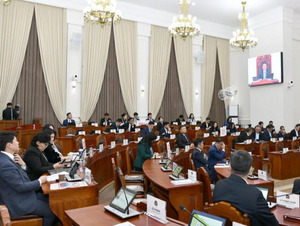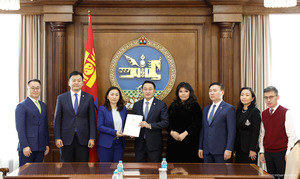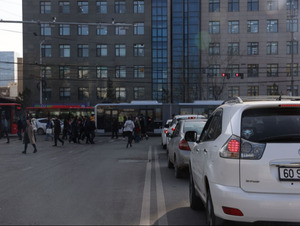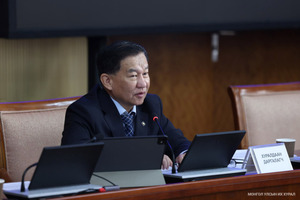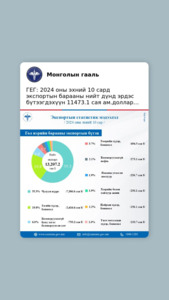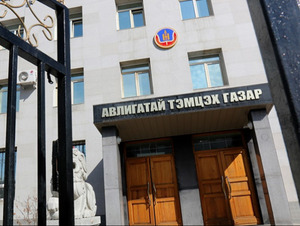L.NOMIN
We interviewed MP D.Erdenebat, Minister of Industry. 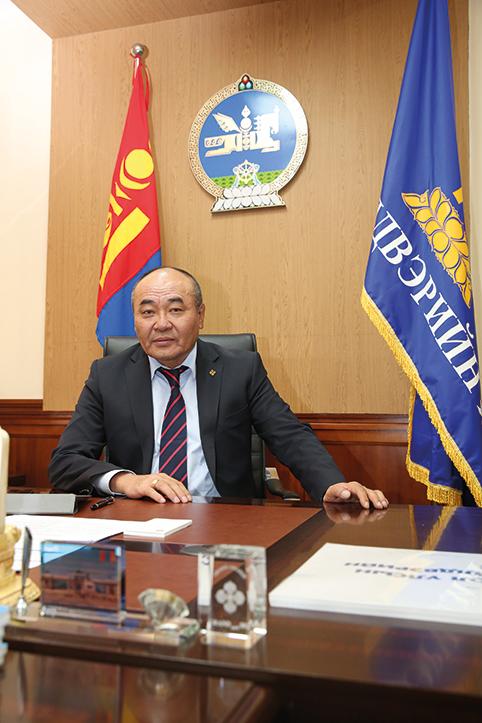
-It has been a while since the Ministry of Industry set an agenda to promote export oriented manufacturing/production. Could you tell us about the progress with the agenda for time being?
-Stabilized export revenue is the one of the key factors for economic growth. We can see it from sharp swings in economy of Mongolia for the past decade. Drop in mineral products’ prices caused decline in the total export revenue in 2012, 2013 and 2015 compared with preceding years. A slight increase in 2014 was achieved solely owing to export activities of “Oyu Tolgoi” project, whereas export by other sectors had shown decrease. However, the performance by value addition is encouraging. In 2015, 14.4% increase was achieved in end-products’ export. Let me give you as an example, cement production. In 2015, Mongolia exported cement worth USD 638 thousand (MNT 1.2 billion), while in 2014 we imported 1.5 million tonnes of cement. Import of cement reduced by 46 percent in 2015, whereas cement production increased by 34 thousand tonnes, i.e. by 1.1 percent. Another area, where attention and action needed is export by non-mining sectors, which shares only 12 percent, i.e. USD 576 million, of total export per year. Current situation of the economy, when the country experiences stabilized low inflation, an opportunity for decreased reliance on mining industry and diversification of economy is opening up.
-What actions have been undertaken to take the opportunity you mentioned here?
-The Cabinet has approved a National Program to Support Export, developed by our ministry jointly with the Bank of Mongolia, Development Bank and Ministry of Finance. The Program aims to support exports by non-mining, including export by agriculture, food, and light industries, through policy and access to finance along value chain in order to increase the export revenue generation of final products and processing by these sectors. The estimated target is increase to one billion US dollars per year. Research and development, advanced technologies and machinery are fundamental for industrial development. In addition, enabling environment will be created by Government regulation and effective cooperation of private businesses to enhance manufacturing industry to the new level. Regrettably, for the past two decades, policy agendas for science and industry in this country were set without link or integration. Missing link and lack of integration resulted in far low processing of raw materials of not only minerals but also traditional livestock for higher value addition. There have been almost no change in the composition of export, thus the level of industrial development has been low, so the competitiveness of the entire industry sector is weak. Based on analyses on afore-mentioned conditions, the Ministry defined the Policy on “Government support for production of end-products based on any raw materials that were farmed, produced, or mined in the country for export and import substitution through value added processing. ” and passed the Law on Support of Manufacturing Industry to regulate related actions and relations. One major indicator for whether or not any country is able to produce an internationally accepted product is an export of knowledge intense, high technology and high value end-product. For our country to achieve this objective, a public-private partnership and private sector engagement are crucial.
-Could you tell us about Policy of your industry in this direction?
-The Ministry has a clear policy. The Parliament adopted a State Policy on Industry last year. The objective of this Policy document was to provide comprehensive action plan aimed at ensuring sustainable development by shifting from agriculture primary produce and mining extraction to more knowledge intensive and value-adding production and services. The goal of these actions is to develop competitive manufacturing and service industries with advanced machinery and equipment and high technology to leverage sustainable development of Mongolia. First, important area of implementation is a legal framework. Establishing a legal framework that supports entrepreneurship and running of business and provides enabling conditions for foreign investors is great importance. Within this framework, the Ministry undertakes revision and update of several laws that were adopted by the Parliament but were not implemented. The Ministry took initiative on the bill of a new Law on Support of Manufacturing Industry and it was passed by the Parliament. Second area is a human resource. Human assets are the driver for Industry sector development. Therefore, engineering and technical staff should be trained at or sent to local and foreign institutes where advanced skills and knowledge are fostered and developed. Third driver of development is financial support. Development of manufacturing industry is enabled when financing is available and accessible. The Government plans to provide financial support through the Industry Support Fund. Soft loans, will not be the only source of funding, other facilities for financial support will come into use. For instance, financial lease services, i.e. equipment leasing, will provide an opportunity for manufacturers and producers to obtain a loan without additional collateral pledging, as to pledge against only equipment they buy. Also, Credit Guarantee Fund offers more facility for support. Producers who are short of collaterals may be provided up to 60 percent guarantee. Fourthly, technology is an important driver. The Government policy focus is to promote technology. Mid-term implementation plans for State Policies and several sub-programs have been developed and approved. The Ministry focuses now on step-by-step implementation.
-This year was announced as the Year of Trade facilitation.
-Trade has facilitative impact on manufacturing industry. Therefore, the year of 2016 was announced as the Year of Trade facilitation and we have been pursuing policies to support local industry through procurement. To explain it, the Ministry has been working to legalize as mandatory the national and local government procurement of only locally produced goods and services that meet quality standards.
In connection with approval of the Law on Support of Manufacturing Industry, the Parliament endorsed the Cabinet to set the rates of customs duties on some products based on specifics of relevant sectors with the purpose to support and protect domestic production. The Government resolution No.332 on increased rates of customs duties on five types of products such as meat and meat by-products, honey, canned products, cement and trolleybuses had impacted increase of production and export of such products. For more details, for example, cement import reduced by 46 percent, i.e. MNT 82 billion, and its export increased by MNT 1.2 billion, beef import reduced by 40 percent, i.e. MNT 84 million, and its export increased by 65 percent, i.e. MNT 2 billion, and honey import reduced by 16 percent, i.e. MNT 460 million, whereas beef export increased 10 times, i.e. by MNT 41 million. Only figures of cement, beef and honey export and import shows that this action contributed to stop MNT 82.5 billion import and inject MNT 3.2 billion to domestic economy. Moreover, relevant studies and estimations were made based on requests from over 20 entities and associations such as “Mongolian association of construction material producers”, “Mongolian association of window and door producers”, “White Lake” LLC, “Doloon Boldog” LLC and “Buyant Od” LLC, and we came into conclusion that there are 50 goods of 13 different types to meet over 50 percent of domestic demand and import customs duties on identical products can be increased. Therefore, increased customs duty rates for afore-mentioned products were approved by the Government resolution No.185 dated 2016. This enables stopping import of identical products, increase domestic production, competitiveness, number of jobs and citizens’ income. Another area I would like to draw your attention is, as I mentioned earlier, the approval of the “National Program to Support Export”. As follow up to it, decision was issued to establish an “Investment Fund to Support Export” as a subsidiary entity of the Development Bank. This fund will provide support on export production through long-term loans with lower interests and risks. This also provides opportunity to raise funds from foreign markets through this fund when there is a shortage of domestic sources.
-Economic partnership agreement with Japan is seen as opportunities for domestic producers. Domestic producers received this news with enthusiasm. Are there any other possibilities for similar agreements with other countries?
-Economic partnership agreement between Mongolia and Japan was signed on February 10, 2015. Under the implementation framework, ongoing effort is made to make it effective by June. The EPA is of great significance to attract investment from Japan to Mongolia, and furthermore, to introduce technologies to domestic production, improve quality of goods and products, increase competitiveness of our exported products, diversify our exports, export products to Japan and trade goods and products jointly to other countries. Also, when the agreement becomes effective, it will facilitate increased trade and transactions between two countries, investment, export of value-added industrial products and export earnings. Under the EPA our domestic producers will have an opportunity to export to Japan woven and knit wool and cashmere products, some types of leather boots, dairy and processed meat products, vodka, wine and some types of juices, jam and mining products with discounted rates of customs duties under favourable terms and conditions. The EPA with Japan is the first free trade agreement of Mongolia, thus we will make great efforts with regard to implementation. Regarding future free trade agreements, several working groups are currently working on studying proposals to conclude free trade agreements made by People’s Republic of Korea, People’s Republic of China and Eurasian Economic Commission.
-Four consortiums have expressed their interest to participate in the tender to build a crude oil processing plant which is one of the major activities of the Ministry of Industry. The matter that has been under discussion for 26 years is about to be implemented now.
-I should note that the relevant ministry in previous Cabinets has been supporting the idea of building this plant. Accordingly, 15 entities were awarded licenses to process oil. This year we announced a tender on construction of a crude oil processing plant and transmission pipelines for 2 weeks starting on March 23 and we received proposals from four consortiums on April 7, 2016. Before the end of this year we will select the investor for the construction of the plant and complete the plant construction designs. Moreover, we plan several activities such as announcing crude oil transmission pipeline concession and commencing installation of transmission pipes.
-Wool and cashmere export has been quite low. It seems we lack a policy to facilitate trade, in addition to its supply. It is typical that when our export products are sold in a foreign country, they are placed in a corner of one shop with quite a high price. It slows turnover and gives an impression to buyers in that our products are very expensive. Thus, it might be helpful to have a special Mongolian shop. Has there been any research in this regard? What do you think about it?
-Wool and cashmere sector is the major export sector. Out of total volume of cashmere, 85 percent is exported as scoured, 12 percent is exported as carded/combed and only three percent is exported transformed into end-products. Value addition in this sector will increase export earning to MNT 1 trillion. In order to achieve this, we need to promote our end-products internationally. “Mongolian Noble Fibre” certification mark was developed with intention to enable penetration to international market. One of ways for becoming known internationally and increasing export is link to international trade network.
-Spinning and knitting equipment of wool and cashmere is very expensive. Processors tell that they face difficulties to buy them with loan due high interest rates and shorter term.
-With an objective to solve this problem, various forms of support were included in the Law on Support of Manufacturing Industry adopted last year. The Law provides that a local processor or manufacturer, who exports over 30% of produced goods will receive compensation to cover the difference between the interest rate of commercial loan and investment loan when it is used the commercial loan for the technology upgrade and for the purpose of funding working capital of export. In this way the Law provides an opportunity to obtain a low interest commercial long-term loans rather than a short-term.
-What definition will you use to define a brand?
-According to the American Marketing Association, the brand is a name, term, design, symbol, or any other feature that identifies one seller’s good or service as distinct from those of other sellers. In general, the brand is an expression of the value of the given product and a lot of things depend on how such expression is perceived by customers, how the value is delivered and maintained. Our cashmere products have a high potential to compete at the international market since as a fiber, raw materials themselves own are known for its superiority and uniqueness. Therefore, we must make excellent products of these raw materials,. In addition to product brands we have an opportunity to use quality certification mark to export our products. For this exact purpose, “Mongolian Noble Fiber” quality certification mark was developed to be used for luxury wool and cashmere products and has been registered in 33 countries. It is the first quality certification mark registered internationally. Registration of this certification mark was supported by the Government and an international project. Now the task for our processors and manufacturers is to deliver high quality products that meet standard requirements and maintain its quality and reputation.
-Among other international donor funded projects highlight was made on Asian Development Bank funded Agriculture and Rural Development project (ARDP), implemented during 2009-2015 to provide great support to the light industry. Will this project be continued and if yes, how will the project proceed?
- In cooperation with the Asian Development Bank we have been successfully implementing projects to support light industry. The year 2016 is the ADB’s 50th anniversary and 25th anniversary of cooperation between Mongolia and ADB. We have developed multilateral cooperation with ADB. Regarding the light industry sector, an Agriculture and Rural Development Project, USD 14.72 million Grant project, was successfully implemented in 2009-2016. As a result of successful implementation of this project, which supported raw materials processing entities and end-product manufacturers, an additional financing project starts its implementation from March 2016. This project will be financed by USD 50 million soft loan from ADB. Most of this project funding, i.e. USD 41.3 million will be on-lend through commercial banks for value chain financing to enterprises in such sectors as skin and hide, wool, cashmere, meat, dairy, apparel, intensified farming, greenhouse farming, fruit and berry, bee-keeping, seed production, animal selection and breeding. The loan amount is up to USD 3.0 million per entity with an annual interest rate of 8 percent for the term of up to 7 years, with three years of grace period. The threshold of the loan amount was lowered compared to the previous project from USD 600 thousand to USD 150 thousand to give an opportunity for small and medium enterprises to obtain the loan, and in the event of lack of collateral assets, they will have access to the Government Credit Guarantee Fund. Moreover, on the top of the loan, the project will finance improvement of lab capacity of research institutions with attached trainings and capacity building to improve skills of lab technical staff at research organizations.
-Are there any projects similar to the Asian Development Bank’s project, which supports the wool and cashmere sector with loans and assistance?
-It must be noted that ADB project is not the only, there are some other projects and programs implemented in cooperation with other foreign institutions in this sector. In addition to financing issues, training and capacity building to improve and develop professionalism of human resources is important. A resident office of the World University Service of Canada was recently opened in Mongolia with assistance of the Department of Foreign Affairs of Canada and the “Uniterra” program, implemented in developing countries, was launched. Within the scope of this program, the first actions undertaken were capacity building in the wool and cashmere and construction sectors. Also, there are a number of other projects have been successfully implemented in Mongolia such as project implemented with assistance of the Ministry of Foreign Affairs of Netherlands to help exporting cashmere home textile to European markets, and project implemented through the International Trade Organization to assist female manufacturers to enter international markets to sell their products. My understanding is that these projects are supporting cashmere production because they see potential of our cashmere products to enter and compete at the international markets. Our manufacturers are making effort to use fully the support from these projects and increasing their exports.







